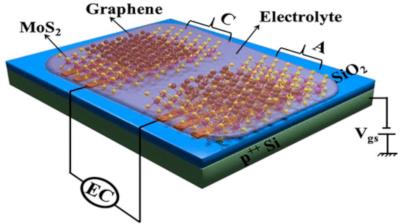Researchers from the Indian Institute of Science have developed ultramicro-electrochemical capacitors with two-dimensional (2D) molybdenum disulphide (MoS2) and graphene-based electrodes. The development has great potential for wearables and implantable electronics as well as for sensors and miniature “smart” technology.
The miniature energy storage device uses graphene Flakes and MoS2 alternately in each electrode - the cathode and anode. Gel was used as the electrolyte, which makes it possible to integrate micro-supercapacitors into chips. This would be difficult if not impossible with a water-soluble electrolyte. The capacitor showed a capacitance of 1.8 mF/cm2 for a single-layer structure (graphene-MoS2). The multilayer electrode structure, consisting of multiple alternating layers of graphene and molybdenum disulfide, gained 30 times greater capacitance, or 54 μF/cm2.
As the scientists explain in their work, two-layer materials such as MoS2 are semiconductors and actually form pn junctions (transistor structures). The multiple junctions cause the ions to be distributed between the electrode layers rather than concentrating solely at the electrolyte-electrode interface. The electrodes themselves become energy stores. This multiplies the capacity of the smallest supercapacitors and promises them good prospects as a power source for portable electronics.
The team sees this study as a benchmark development of an ultramicro-electrochemical capacitor for ultrahigh charge storage capability.


